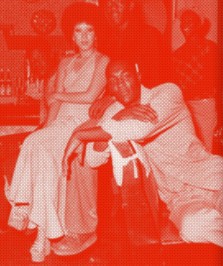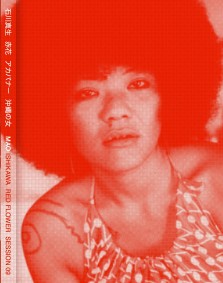|
Red
flower : the women of Okinawa / Ishikawa Mao (photography and
text) ; translation by Jun Sato. - New York : Session
press,
2017. - 112 p. : ill. ; 33 cm.
ISBN
978-0-692-81744-5
|
NOTE
DE L'ÉDITEUR : Red Flower, The Women of
Okinawa, is the first United States monograph by Okinawan
photographer Mao Ishikawa. Red
Flower consists of 80 b/w photographs that date from 1975
to 1977 in Koza and Kin, Okinawa, primarily from Ishikawa’s
first book Hot Days in
Camp Hansen by A-man Shuppan in 1982, but it also includes
unpublished work from the same period. Red Flower
exhibits Ishikawa’s celebration of the courageous and honest
lives of women she met and befriended while working at military bars at
a time when social and political tensions between the US and Japan were
on high alert. It consists of five chapters of pictures, followed by
her essay dedicated to the publication : girls gossiping about
boys, working at bar, meeting their boyfriends at home, enjoying
themselves at the beach, and their children for the future of Okinawa. Red Flower is the
pivotal work for Ishikawa, since it marks the starting point of her
subsequent long career as a photographer.
|
 |
Her
attendance of Shomei Tomatsu’s class at Workshop
photography school in spring 1974 seems to have had a strong influence
on her style ; their close association as friends and
teacher/student continued till his death in 2012. Martin Parr
identifies her work as " post-Provoke " in The Photobook: A History
Volume III (p. 90), observing the strength of her
photography
is charged by its directness and rawness, in contrast to the stylized
symbolism preferred by the previous generation of Provoke
photographers. Most importantly, it is crucial to note that her work is
often delivered from the result of her pure pursuit of her subject
matter. Especially for this particular project, Ishikawa’s
engagement to the subject was enormous ; she worked as a
server at
the bars along with the other girls and had relationships with boys she
met there for two years. Thus, her personal involvement enables her to
capture the actual events and scene without theorizing or
romanticizing. In Red
Flower, Ishikawa
reveals her very honest personal documentary in all sincerity, while
still maintaining enough detachment from the subject to be able to
perfectly capture the scenes with her sharp eyes.
|
|
GILDAS
VENEAU : C’est
avec [des] clichés pris dans sa ville natale que la
photographe
japonaise Mao Ishikawa débuta sa carrière. De
1975 (elle
a alors 22 ans) à 1977, tandis que la guerre du
Viêt-Nam
s’achève, elle est employée dans des
bars
fréquentés exclusivement par des soldats
noirs-américains de la base d’Okinawa, avec
lesquels elle
ne tarde pas à nouer des liens. Encore
aujourd’hui, du
fait de sa position géographique à
équidistance du
continent asiatique et du Japon, Okinawa reste un poste militaire
stratégique. C’est en partie en réponse
à
l’histoire douloureuse de cette « porte
militaire du
Sud » que Mao Ishikawa a photographié le
quotidien de
sa vie avec ses amis américains et ses compagnes japonaises
barmaids.
Chambres, bars, plages et coins de rue sont les lieux
de portraits hâtivement posés, comme en
léger
déséquilibre, et les terrains de capture en vol
de
moments d’intimité alcoolisée,
amoureuse, pensive
ou rigolarde. Entremêlement de sourires, de gestes et de
regards,
il n’est guère d’images au fil des pages
rythmées comme un morceau de cool jazz où ne
s’esquisse une danse, un jeu, où ne se
côtoient
l’excitation, puis des instants de relâchement
élégant qui disent, aussi, toute la
fugacité de la
parenthèse pour cette petite bande.
En tous les cas, il
s’agit dans ces clichés du lien étroit
et
profondément bienveillant unissant les modèles
entre eux,
et ceux-ci à leur portraitiste. Ishikawa s’affirme
de la
sorte en tant que photographe, femme et japonaise, dans un
environnement qui ne l’attendait pas forcément
ainsi. La
douceur du noir et blanc déplace la question des
frontières, de l’appartenance ethnique, la
misère
de ces héros de quelques jours, et la gravité du
moment
historique, dans une brume qui doit autant à la
fumée des
cigarettes et à la tendresse du souvenir.
☐
Commentaire
mis en ligne par la Maison
Européenne de la Photographie à
l'occasion de la parution de Hot
days in Okinawa en 2013.
|
| COMPLÉMENT
BIBLIOGRAPHIQUE |
- Ishikawa
Mao, Higa Toyomitsu, « Atsuki hibi in Kyanpu
Hansen !! [Hot days in camp
Hansen !!] »,
Okinawa : Aaman Shuppan, 1982
- Ishikawa
Mao, « Hot days in Okinawa », Tokyo : Foil, 2013
|
- Lou
Baudillon Coutet, « Ishikawa Mao, photographe d'Okinawa
», Paris : L'Harmattan (Histoires des idées et des
arts), 2021
|
|
|
| mise-à-jour
: 20 mai 2021 |

|
|
|
|